1984 NISSAN 300ZX wheel
[x] Cancel search: wheelPage 24 of 38

CHASSIS AND BODY MAINTENANCE
Checking Front Whe
2 Measure toe-in
Liner parallel to center line of body-
Toe-in = A - 8
SMA124 Front
Toe-in:
1 - 3 mm (0.04. 0.12 in)
6-16
3 Town can be adjusted by varying the length
of steering side rods
SMA727A
"A" standard dimension:
37.5 mm (1.476 in)
inner rocket
SST274A
Alignment (Cont'd)
FRONT WHEEL TURNING ANGLE
a Rotate steering wheel all the way right and
left, measure turning angle on inner wheel
SMA127
Turning angle.
Full turns
Inside
Outside
35" - 39"
27"
~ 31"
Toe-out turn (Insideloutside):
22"30/20"
If it is not within speclfication, check rack
stroke.
Refer to section
ST
Rack stroke
r Rack
Tie-rod inner i. socket Tie-rod inner socket
,Rack -1
Unit mm (in) (Cvlander end housing ndel SST223A
MA-24
.
Page 25 of 38
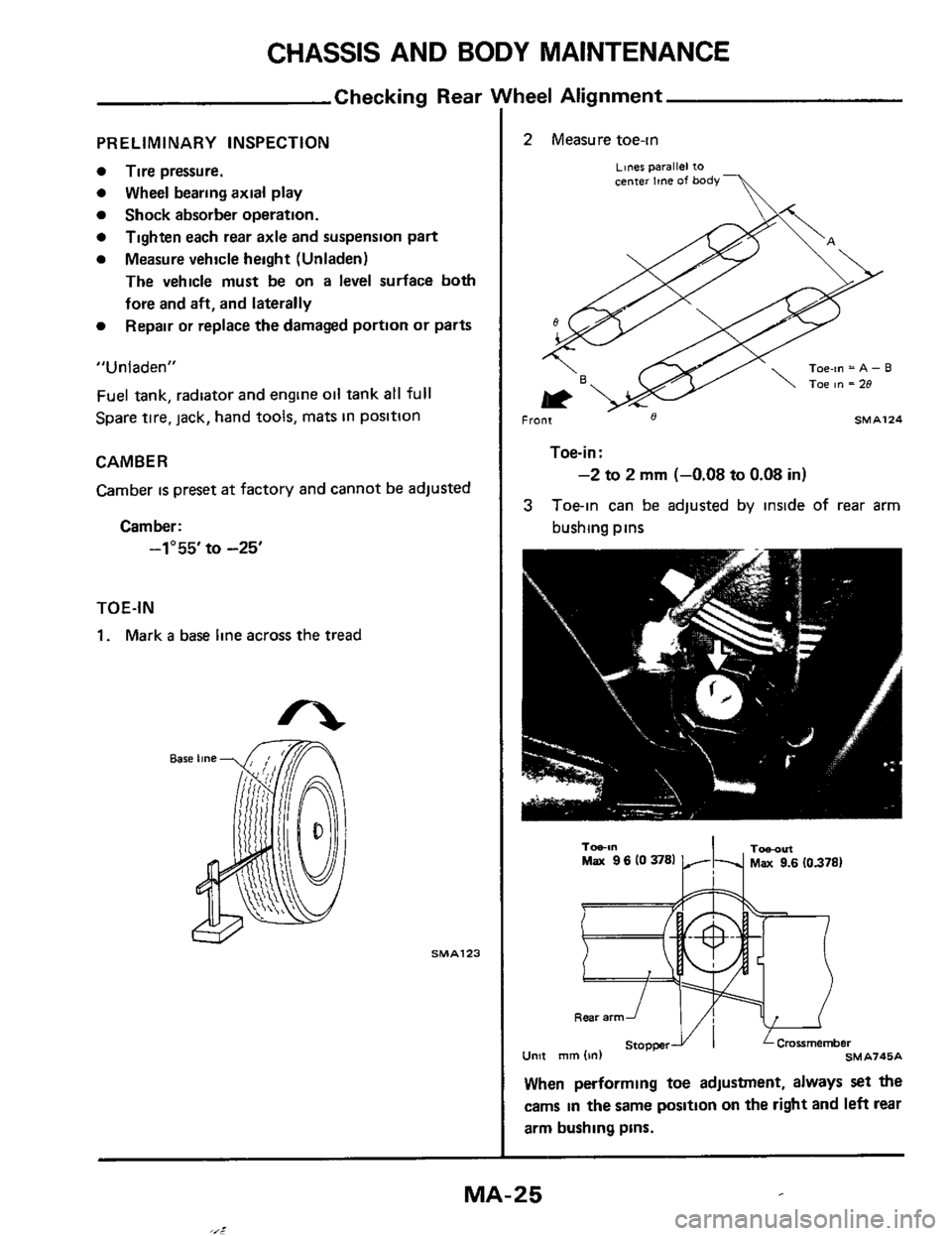
CHASSIS AND BODY MAINTENANCE
Checking Rear
PRELIMINARY INSPECTION
0 Tire pressure.
0 Wheel bearing axial play
0 Shock absorber operation.
0
0 Measure vehicle height (Unladen)
Tighten each rear axle and suspension part
The vehicle must be on a level surface both
fore and
aft, and laterally
Repair or replace the damaged portion or parts
0
"Unladen"
Fuel tank, radiator and engine oil tank all full
Spare
tire, jack, hand tools, mats in position
CAMBER
Camber
is preset at factory and cannot be adjusted
Camber:
-1"55'tO -25'
TOE-IN
1. Mark a base line across the tread
SMA123
nee1 Alignment
2 Measure toe-in
~~ner parallel to center Ime of body-
Toe-in = A - B
, Front 8 SMA124
Toe-in:
-2 to 2 mm (-0.08 to 0.08 in)
3 Toein can be adjusted by inside of rear arm
bushing pins
Unit
Tobl" TObOltl Max 9 6 10 3781 Max 9.6 (0.378)
When performing toe adjustment, always set the
cams in the same position on the right and left rear
arm bushing pins.
MA-25
,,_l
Page 29 of 38
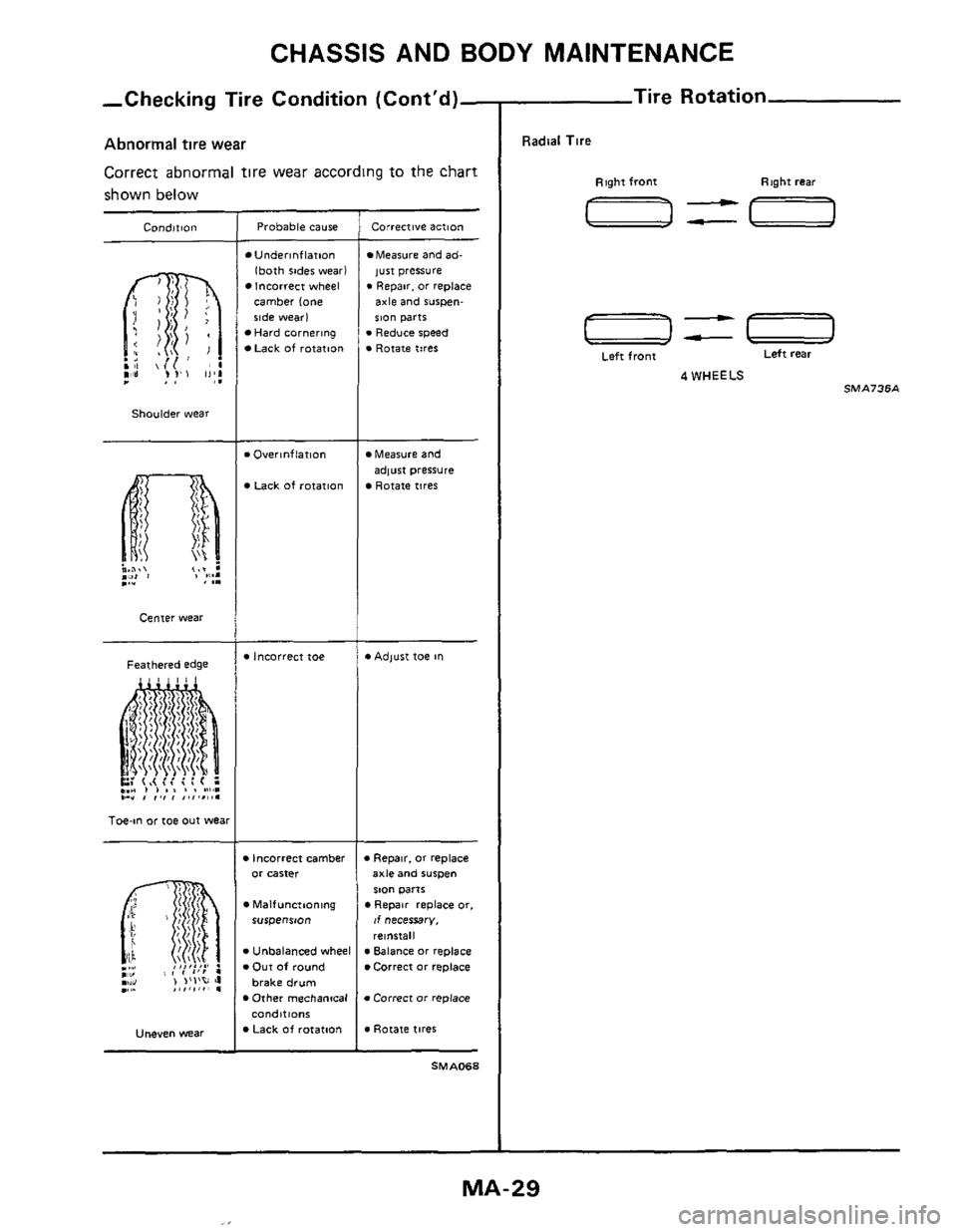
CHASSIS AND BODY MAINTENANCE
,Checking Tire Condition (Cont'd)-
Abnormal tire wear
Correct abnormal tire wear according to the chart
shown below
Condition
Shoulder wear
Center wear
Feathered edge
Toe-in or toe out wea
Uneven Wear
Probable cause
Underinflation
lboth sides wear) Incorrect wheel
camber lone side wear1 Hard cornering
Lack of rotation
. Overlnflatlon
Lack of rotation
.Incorrect toe
rn Incorrect camber or carter
Malfunctioning rurpenrm
v Unbalanced wheel v Our of round
brake drum
Other mechantcal conditions Lack Of rotation
Corrective actton
Measure and ad-
just pressure . Repar. or replace
axle and rurpen- IlO" parts
.Reduce speed . Rotate tires
Measure and
Rotate tires
adlust pressure
*Adlust toe In
Repa~r. or replace axle and iuwm
SlO" parts
If necessary.
rel"6tall
Repar replace or,
m Balance or replace Correct or replace
m Correct or replace
v Rotate tires
SMA068
Tire Rotation
Radial Tire
Right front Right rear
a=-
-== Left rear
Left front
4 WHEELS SMA73SA
MA-29
Page 30 of 38
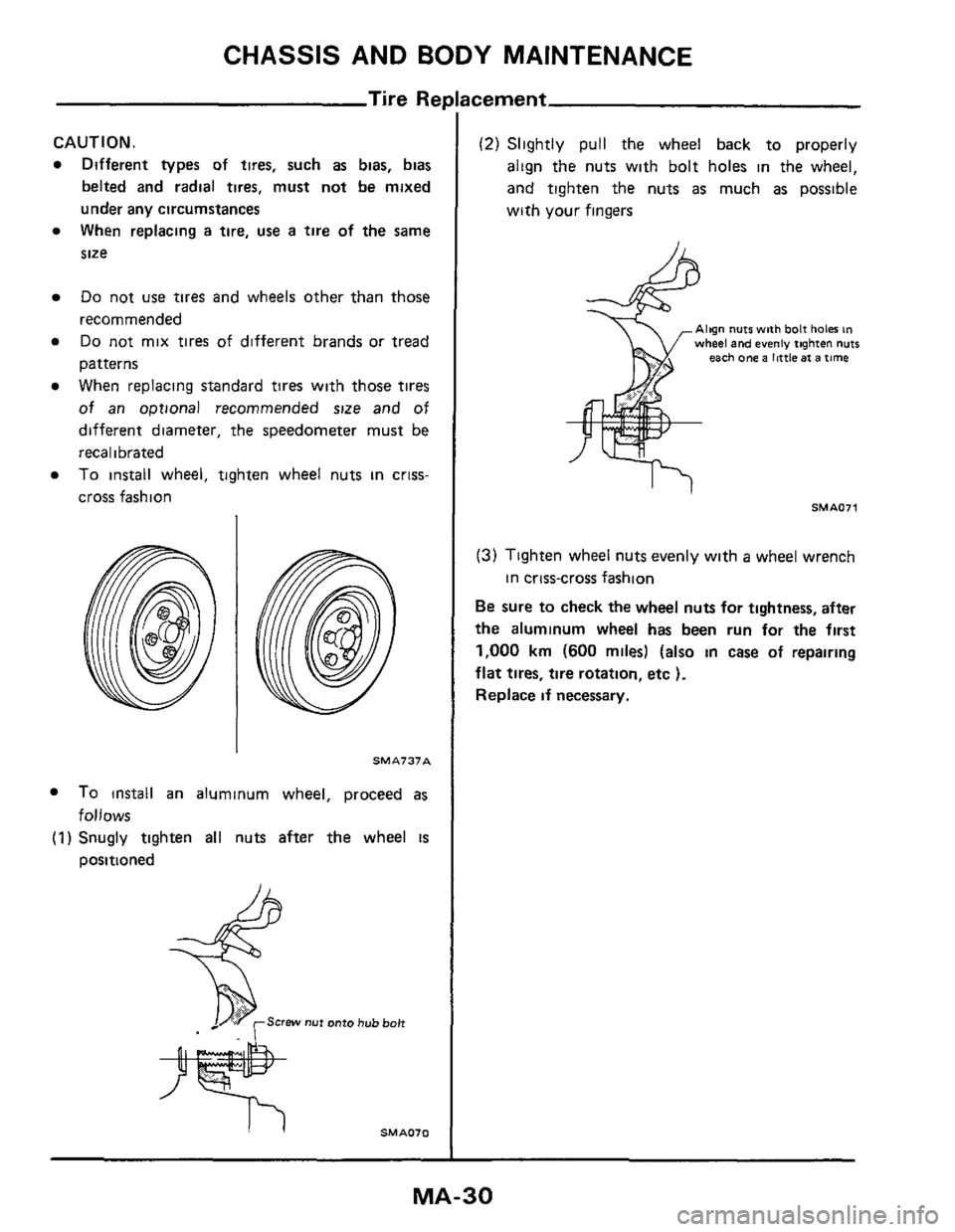
CHASSIS AND BODY MAINTENANCE
Tire Rei
CAUTION.
Different types of tires, such as bias, bias
belted and radial
tires, must not be mixed
under any circumstances
When replacing
a tire, use a tire of the same
size
Do not use tires and wheels other than those
recommended
Do not mix tires of different brands or tread
patterns
When replacing standard
tires with those tires
of an oprional recommended size and of
different diameter, the speedometer must be
recalibrated
To install wheel, tighten wheel nuts in criss-
cross fashion
SMA737A
To install an aluminum wheel, proceed as
(1) Snugly tighten all nuts after the wheel is
follows
positioned
icement
(2) Slightly pull the wheel back to properly
align the nuts with bolt holes in the wheel,
and tighten the nuts
as much as possible
with
your fingers
Align nuts with bolt haler in wheel and evenly tighten nuts each one a little at a time
SMAOll
(3) Tighten wheel nuts evenly with a wheel wrench
Be sure to check the wheel nuts for tightness, after
the aluminum wheel
has been run for the first
1,000 km (600 miles) (also in case of repairing
flat tires, tire rotation, etc ).
Replace if necessary.
in crtss-cross fashion
MA-30
Page 31 of 38
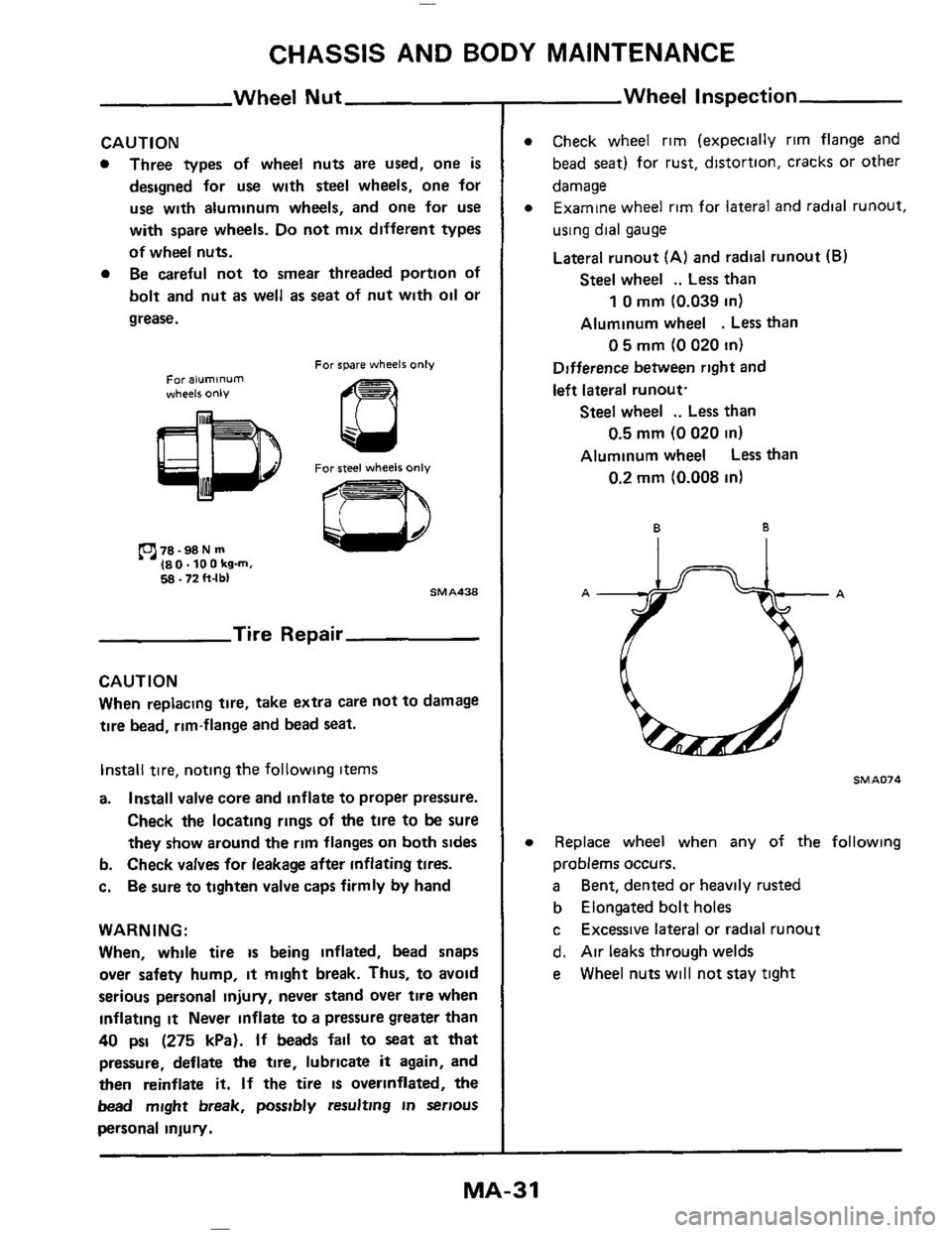
CHASSIS AND BODY MAINTENANCE
Wheel Nut
CAUTION
0 Three types of wheel nuts are used, one is
designed for use with steel wheels, one for
use with aluminum wheels, and one for use
with spare wheels. Do not mix different types
of wheel nuts.
0 Be careful not to smear threaded portion of
bolt and nut
as well as seat of nut with oil or
grease.
For spare wheels only For aluminum wheels only
For steel wheels only
78 -98 N m 180-100kg-m. 5s 172 ft-lb, SMA438
Tire Repair
CAUTION
When replacing tire, take extra care not to damage
tire bead, rim-flange and bead seat.
Install tire, noting the following items
a. Install valve core and inflate to proper pressure.
Check
the locating rings of the tire to be sure
they show around the rim flanges on both sides
b. Check valves for leakage after inflating tires.
c.
Be sure to tighten valve caps firmly by hand
WARNING:
When, while tire
is being inflated, bead snaps
over safety hump,
it might break. Thus, to avoid
serious personal
injury, never stand over tire when
inflating it Never inflate to a pressure greater than
40 psi (275 kPa). If beads fail to seat at that
pressure, deflate
the tire, lubricate it again, and
then reinflate it. If the tire is overinflated, the
bead might break, possibly resulting
in serious
personal inlury.
Wheel Inspection
Check wheel rim (expecially rim flange and
bead
seat) for rust, distortion, cracks or other
damage Examine wheel rim for
lateral and radial runout,
using dial gauge
Lateral runout (A) and radial runout (B)
Steel wheel .. Less than
Aluminum wheel
. Less than
1 0 mm (0.039 in)
0 5 mm (0 020 in)
Difference between right and
left lateral runout.
Steel wheel .. Less than
Aluminum wheel
Less than
0.5 mm (0 020 in)
0.2 mm (0.008 in)
6 B
Ail..,A
SMA074
Replace wheel when any of the following
problems occurs.
a
b Elongated bolt holes
c
d. Air leaks through welds
e
Bent, dented or heavily rusted
Excessive lateral or radial runout
Wheel nuts
will not stay tight
MA-31
Page 32 of 38

CHASSIS AND BODY MAINTENANCE
Balancing Wheels
Cause
Symptom
of unbalanci
correct,vt
action
Wheel static
unbalance
Wheel tramp
Wheel shimmy
lalance statically
Place balance weights here
L0CatlO"J
Wheel dynamic
unbalance
Wheel shimmy
Balance dynamically
Wheel shimmy
n
Heavy locatnoni
u
Wheel shimmy
SMAO7S
Spare Tire
This model is equipped with the Space Saver Spare
tire or the Foldable Spare tire
The spare tire
is designed for emergency use only
It
IS stored in a deflated condition
An inflator (canister or air pump) has been
provided to inflate the spare
The spare tire can be used repeatedly for
emergency situations However, the canister must
be replaced after each inflation
Be sure to obtain the proper size canister for spare
tire
size
CAUTION:
The spare tire
is restricted in driving speed up to a
maximum
of 80km/h (50MPH) for short
distances and emergency use only.
INFLATION WITH APPROVED INFLATOR
1 Before changing tire, carefully read the caution
and directions affixed on both the inflator and
the spare tire
2 Remove the uninflated spare tire and the
inflator from rear compartment
WARNING. Do not inflate at
this point.
3 Jack up front or rear of vehicle as required and
remove the damaged
tire Then mount the
uninflated spare
tire to the axle (Tighten
wheel nuts slightly
)
On aluminum wheels equipped vehicles be sure to
use spare wheel nuts in the tool bag
The wheel nuts for aluminum wheels must not be
used on the spare tire wheel to avoid the wheel
coming off the axle and causing personal injury.
4 Using Canister
(1) With tire valve at 6 o'clock position. inflate the
spare tire with the canister Place tire canister
on the
tire inflaction valve and push squarely
until
gas can be heard entering the tire It takes
about
3 minutes
WARNING:
The metal parts of the canister become extremely
cold during inflation and can cause frost bite.
Therefore, avoid contact with the metal, use a
glove or other means
of protection.
MA-32
Page 33 of 38
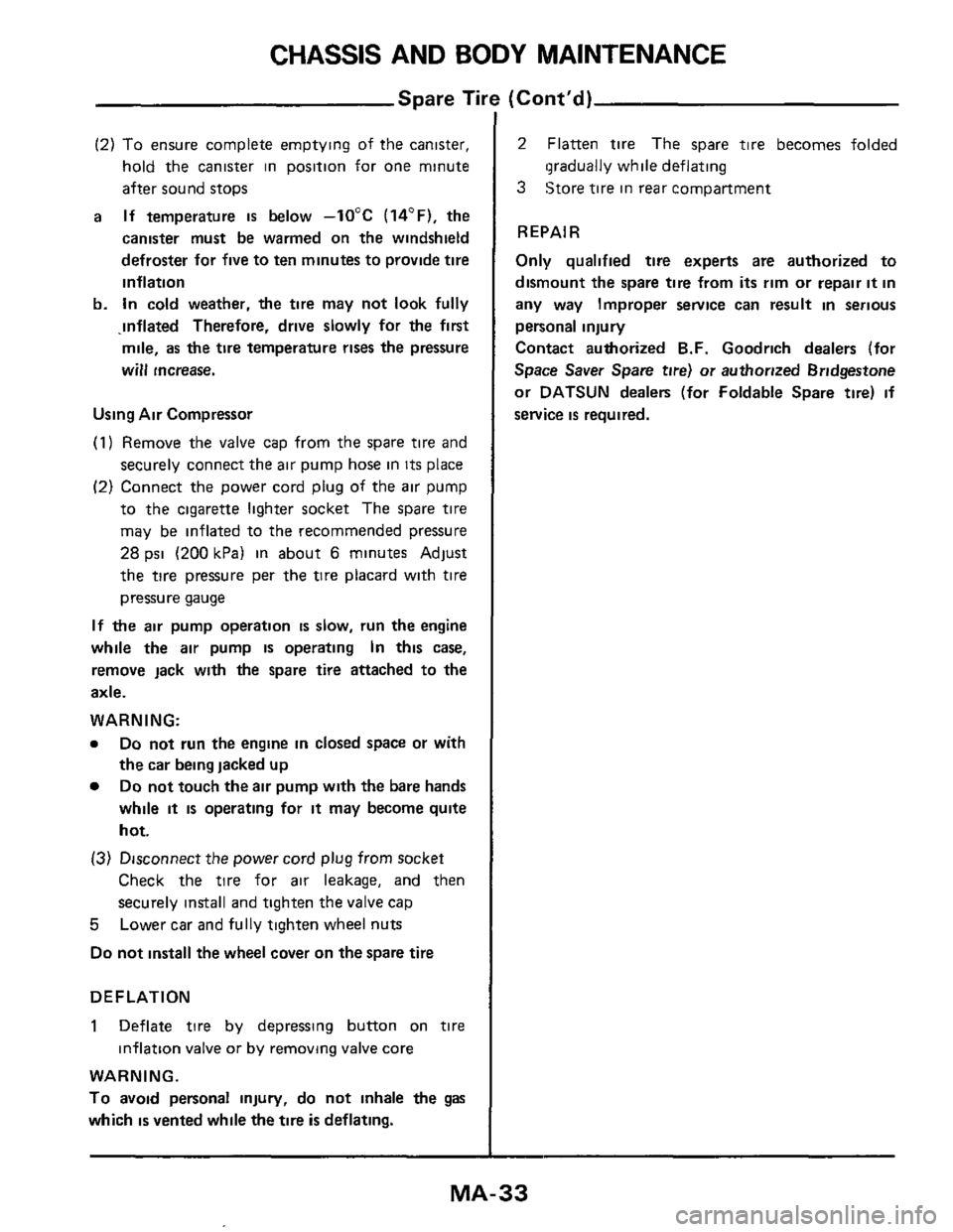
CHASSIS AND BODY MAINTENANCE
Spare Til
(2) To ensure complete emptying of the canister,
hold the canister in position for one minute
after sound stops
If temperature is below -10°C (14OF), the
canister must be warmed on
the windshield
defroster for five to ten minutes to provide
tire
inflation
b. In cold weather, the tire may not look fully
.inflated Therefore, drive slowly for the
first
mile, as the tire temperature rises the pressure
will mcrease.
a
Using Air Compressor
(1) Remove the valve cap from the spare tire and
securely connect the air pump hose in
its place
(2) Connect the power cord plug of the air pump
to the cigarette lighter socket The spare
tire
may be inflated to the recommended pressure
28 psi (200 kPa) in about 6 minutes Adjust
the
tire pressure per the tire placard with tire
pressure gauge
If the air pump operation is slow, run the engine
while the air pump is operating In this case,
remove jack with
the spare tire attached to the
axle.
WARNING:
0
0
Do not run the engine in closed space or with
the car being jacked up
Do not touch the air pump with the bare hands
while
it is operating for it may become quite
hot.
(3) Disconnect the power cord plug from socket
Check the
tire for air leakage, and then
securely install and tighten the valve cap
5 Lower car and fully tighten wheel nuts
Do not
install the wheel cover on the spare tire
DEFLATION
1 Deflate tire by depressing button on tire
inflation valve or by removing valve core
WARN1 NG.
To avoid personal injury, do not inhale the
gas
which is vented while the tire is deflating.
(Cont'd)
2 Flatten tire The spare tire becomes folded
3
REPAIR
Only qualified tire experts are authorized to
dismount the spare tire from
its rim or repair it in
any way Improper service can result
in serious
personal injury
Contact aumorized B.F. Goodrich dealers (for
Space Saver Spare tire)
or authorized Bridgestone
or DATSUN dealers (for Foldable Spare tire)
if
setvice is required.
iqradually while deflating
Store tire in rear compartment
MA-33
Page 36 of 38

SERVICE DATA AND SPECIFICATIONS (S.D.S.)
Used belt deflection
Limit
Adlusted deflecraon
Engine Maintenance
INSPECTION AND ADJUSTMENT
st deflec. TIon Of
new belt Pedal free Play "A"
Alternator
1 -3 IO M -0 121
Arr conditioner I 16 I 9-11 I 7-9 compressor (0631 1035 0431 (028-0351
ADDlted pushtng force I 98 N 110 kg, 22 Ibl
21
10831 Power steering 011 pump
Oil capacity
13.16 10-13
1051 .0631 (039-0511 ~~
unlt P IUS qt. Imp qtl
Wheel alignment IUnladenI
Camber
degree
Caster degree
-35' to 55'
5*50.7"30
Coolant capacity Unlt &? IUS qt. Imp qtl
Wlth 041 falter
Wtthout
001 filter
VG30E & VG30ET
4
0 (4-1 /4, 3-1/21
3 3 13-1/2.
2 7/81
Spark plug
VG30E
I VG30E I VO3OET
105 111-1/8, 91/41
Front wheel turning angle Toe-out turns
Inner wheelIOufer wheel
degree
Plug uaD I 10- 1 1 mm 10039-OW3 in1
22"30'/20'
altitude I 20*2'/650t50 I 20t2'/650f50
standard iype
Hot type
Cola woe
condmon
VG30ET I 20 f 2"/700 f 50 I 20 + 2'/650 t 50
BCPR6ES.11 BCPR6E-11
BCPRSES.11 BCPRSE-11
BCPR7ES.11 BCPR7E-11
TIGHTENING TORQUE
U"lt Nm kg-m ft-lb
Full turns Inner wheel degree
Outer wheel degree
Or1 pan drain plug 29-39 30-40 22-29
Spark plug 20-29 20-30 14-22
Fuel hme clamps 10-15 010-015 07-11
35" .39"
27" .31'
-Chassis and Body Maintenance-
INSPECTION AND ADJUSTMENT
Clutch
Unlt mm 11nI
Pedal height "H" I 195 - 205 I7 68.8 071
Front axle and front suspension
Wheel bearmg preload
IAr measured at wheel hub bolt1 6 86.14 61
With used parts N Ikg, Ibl 1 1 67.7 75 IO 17-079.037- 1741
Kingpin mclination degree I 12'15'- 13'45
degree I 6'- 16
Out 3 (0 0361 - In 3 (0 0361 Side lip IReference datal mm/m lin/ftl
37 5 I1 476) Standard side rod length "A" mm bnl
* On power steering models, wheel turning force la1 circumference
afsteeringwheellof98-147NI10-15kg.22-33lblwith
engtne at idle
Rear axle and rear suspension
Camber degree I -1-55' fa -25
mm (4") I -2 to 2 1-0 08 to 0 081 Toe-,"